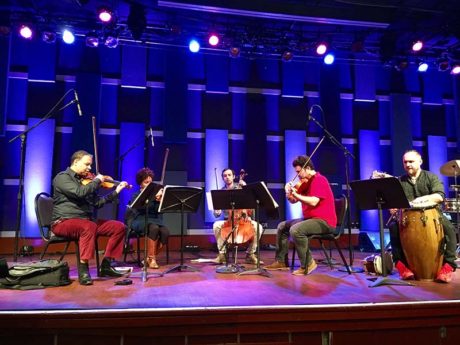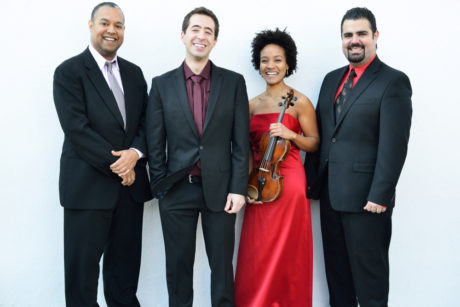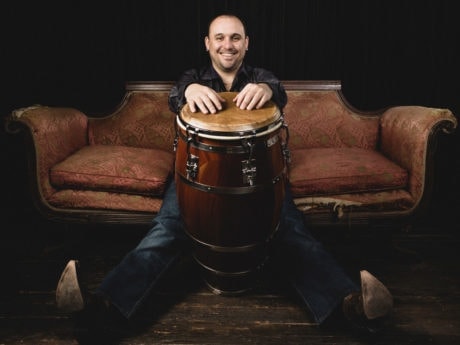Once again, LiveConnections Presents (“LCP”) curator Mary Wheelock Javian’s musical matchmaking has produced a lively evening of musical discovery. This time it was the pairing of the Harlem Quartet with percussionist and University of the Arts professor Arturo Stable.

As usual with LCP’s offerings, the first set featured the invited string players. The Harlem Quartet’s two pieces, on paper, were more conventional young string quartet fare than other LCP evenings I’ve attended: no Radiohead songs, no video, no recorded track to play against, but instead a composition by Harlem Quartet violinist Ilmar Gavilán’s father Guido and Mozart’s “The Hunt” Quartet. In performance, however, it was quite different from any cliché of “chamber music.”
Acknowledging they were in an informal setting where the audience was eating and drinking during the performance, Harlem Quartet played the set as “party music.” The first piece, “Guaguancó,” is after a Cuban dance style, which is defined as “a subgenre of Cuban rumba.” Guaguancó is one of the last styles anyone would associate with string quartets, and Ilmar Gavilán acknowledged it created challenges for them to learn to play. Like all rumba, guaguancó is heavily rhythmical, centering on a syncopated clave, or key pattern. The style also depends on percussion. This gorgeous composition, in addition to providing each member of the quartet moments to shine, also required skills rarely seen from string players: prolonged, intricate percussion sections beaten on the instrument (particularly by cellist Felix Umansky and violist Jaime Amador: Gavilán commented that they had to find ways of playing that kept the insurance companies happy) as well as passages where a musician had to pluck the clave with the left hand while bowing other notes with the right. There were even moments where a player had to sing while playing. (So I lied about the conventionality; so sue me.)

Between pieces, Umansky explained that Mozart’s composition (technically: String Quartet No. 17 in B-flat Major, K. 458) was originally performed in the an 18th century setting equivalent to the World Cafe Live, which affected their approach to the piece. The musicianship was excellent. But there was a greater acknowledgement that we, the audience, were in the room with them. Violinist Gavilán’s facial expressions often reminded me of bandleaders of rumba or swing bands, sometimes looking straight at us. At one point in the lively first movement, I felt he was asking “did you it echo hunting horns like I told you?” A dramatic fermata concluding a dynamic passage later in the movement with punctuated with a gesture with his bow that intentionally drew a laugh. Great musicianship (violinist Melissa White, a Curtis graduate, also needs to be mentioned) played with a tremendous sense of joy.
Introduced the second set by acknowledging that Mary Javian and LCP had pushed him out of his comfort zone for the evening. In addition to “El Fénix Negro (The Black Phoenix),” commissioned for Stable and Harlem Quartet, he had been asked to play twenty minutes solo. “Percussionists can play for ten hours by ourselves,” he quipped. “We just don’t expect other people to listen to us.” The resulting composition, “Thunderous Inner Vibrations,” features his his experimentation with pre-recorded sound, while Stable plays a wide range of percussion, including trap set, congas, African drums, kalimba, and a variety of shakers. Much of the recording consists of excerpts of an interview with someone Stable identified, without naming, as a “philosopher and composer” important to him. Other sections include recorded instrumentals, including one where Stable plays a conga duet with himself. A comment on the recording that “we are music, we are living music” captured the spirit of the piece.
Stable remarked that, although he’s composed for a variety of ensembles, including orchestras, he’d found composing for a string quartet particularly challenging. I won’t comment on “El Fénix Negro” in depth (I found myself too swept up in its flow), but as it ended I found myself wondering why there isn’t an entire repertoire of music for string quartet and hand percussion: with a percussionist of Stable’s sensitivity, the combination felt the most natural thing in the world.
LiveConnections Presents’ next concerts are on April 18th and June 2nd. Both deserve to be on a new music lover’s calendar.

Running Time: Approximately two hours, with one intermission.
Harlem Quartet + Arturo Stable performed for one-night-only, on February 24, 2017, at World Cafe Live – 3025 Walnut Street, in Philadelphia, PA. For future LiveConnections Presents events, visit the concert schedule.




